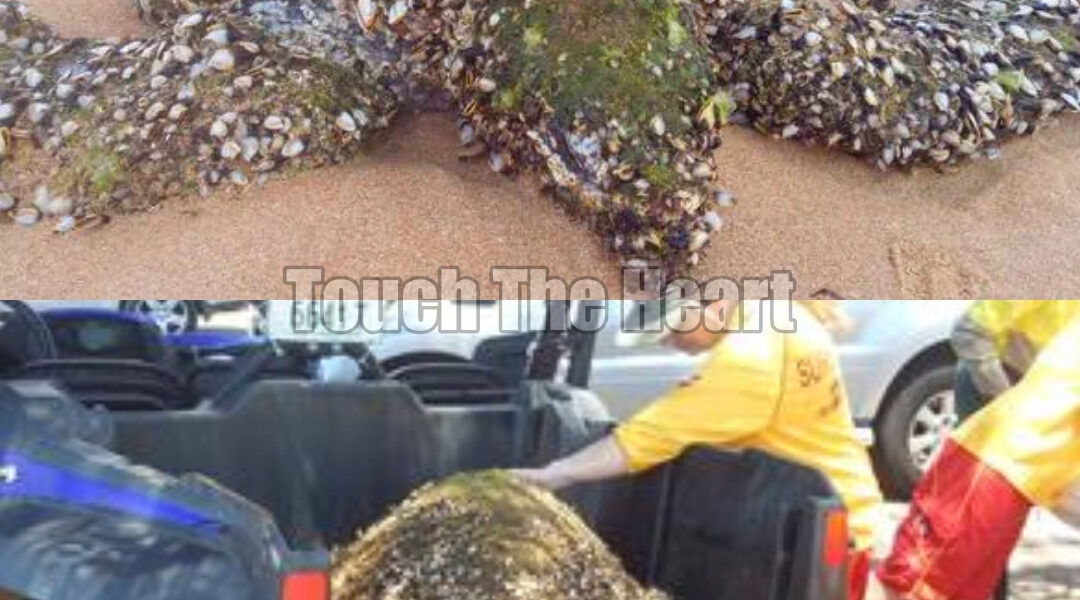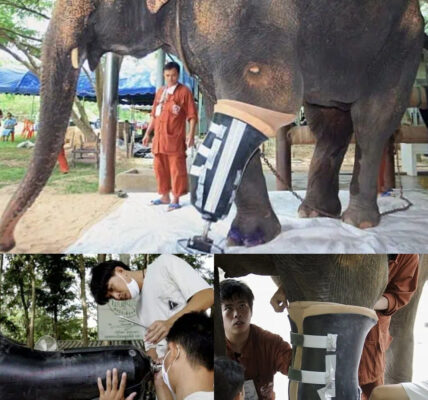When beachgoers at Newport first saw it, they thought it was already gone.
A lifeless shape washed up on the sand — its shell thick with barnacles, its body motionless, its colors dulled by months at sea. It looked like a relic of the ocean, something long past saving.
But then, a small movement. A faint lift of the head.
The turtle was alive.

A Struggle for Survival
On that Saturday morning, Newport surf lifesavers were used to emergencies — swimmers in distress, overturned boats, the roar of surf and shouts of panic.
But this rescue was different.
Lying half-buried near the shoreline was a male green sea turtle, weak and barely breathing. Its once-smooth shell was almost hidden beneath layers of barnacles — a living creature turned into a ghostly sculpture by time and tide.
“It looked gone,” one rescuer said. “We couldn’t believe it was still breathing.”
The Race to Save a Life

The lifesavers acted immediately.
They poured gentle streams of seawater over its shell and covered it with wet towels to keep it moist. One volunteer knelt beside it the entire time, whispering softly as if words could coax it back to strength.
“It didn’t struggle,” recalled Rosie Elliott, one of the rescuers. “It just lay there, as if too tired to fight anymore. But it was alive — and that was enough reason to try.”
They alerted the Taronga Wildlife Hospital, whose team rushed to the scene. The turtle was carefully lifted — heavy, frail, ancient — and transported for emergency treatment.
A Fragile Hope
At the hospital, veterinarians discovered what months of struggle had done.
Tests showed gas buildup in its digestive system, likely caused by ingesting plastic or marine debris. The gas had affected its buoyancy, keeping it trapped at the surface — unable to dive, unable to feed, drifting helplessly until it was carried ashore.
“It’s been in this condition for quite some time,” said hospital manager Libby Hall. “The barnacles tell us that. They only grow that way on animals that have been immobile for months.”
Even so, the team refused to give up. They began hydration therapy, antibiotics, and careful feeding — working tirelessly to restore what the ocean had nearly taken.

Between Life and Loss
For now, the outcome remains uncertain.
Some turtles in this condition don’t recover. But there are miracles — slow, steady comebacks that defy every expectation.
“We can only hope,” said Hall. “It’s in nature’s hands now. All we can do is give it a chance.”
Each day, the turtle is monitored closely. Staff take turns caring for it, cleaning its shell, gently removing layers of barnacles — a symbolic peeling away of all the pain it’s endured.
A Symbol of the Sea’s Fragility

To the Newport lifesavers, the image of that barnacle-covered turtle is one they won’t forget. It’s a stark reminder of the silent battles fought beneath the waves — of creatures struggling to survive in a world filled with plastic, pollution, and rising seas.
“It didn’t come to us by accident,” said one volunteer. “Maybe it was a message — to remind us that the ocean is alive, and it needs us to care.”
And so, while the turtle rests in its recovery pool, the people who saved it wait — hoping that one day, weeks or months from now, they’ll hear the words every rescuer longs to hear:
“It’s ready to go home.”
Because sometimes, survival is not just about strength.
It’s about being found.
It’s about being given one more chance to live — and to swim free again beneath the waves.




